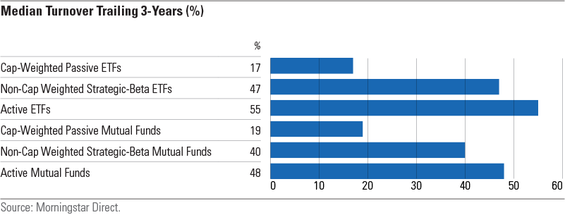Exchange-traded funds tend to be more tax-efficient than mutual funds, chiefly because they can typically distribute fewer and smaller capital gains, if they distribute any at all. ETFs’ tax efficiency has been a key selling point for tax-sensitive investors who prefer greater control over the timing and magnitude of the capital gains bills from the funds in which they invest.
Morningstar Research Services’ paper, “ Measuring ETFs’ Tax Efficiency Versus Mutual Funds,” evaluates the sources of this tax efficiency as compared with that of actively managed and index mutual funds.
Below, see some of the findings from our research.
Low turnover partially drives ETF tax efficiency
As of March 2019, 84% of ETF assets were invested in funds underpinned by market-cap-weighted indexes. These funds’ turnover was lower than any other cohort we examined—save for index mutual funds tied to similar benchmarks—and while it is not the primary driver of ETF tax efficiency, it is a contributor.
The chart below illustrates that the median turnover among the cohort of market-cap-weighted passive ETFs was 17% over the three years through the end of 2018. This is significantly lower relative to every other group (including non-market-cap-weighted and active funds), except for the cap-weighted index mutual funds, which had a median turnover of 19%.

Data as of December 31, 2018.
Structure is the linchpin of ETF tax efficiency
ETFs’ structure is the primary driver of their tax efficiency. The ability to regularly purge low-cost-basis securities in-kind is a key advantage over traditional open-end mutual funds and has allowed even high-turnover strategies to avoid distributing gains.
For this reason, ETFs usually have a more favorable tax profile than open-end index mutual funds that track the same benchmarks. Our analysis showed that outflows tend to hurt open-end mutual funds’ tax efficiency, while ETFs tend to be resilient and may even benefit from the opportunity to purge low-cost-basis securities from their portfolios.

Data as of 2018 fiscal year-end of each fund.
The limitations of ETF tax efficiency
ETF tax efficiency should not be conflated with tax immunity. Investors in ETFs will still pay taxes on regular distributions of income, and they will be on the hook for capital gains taxes when they sell an ETF for more than they paid for it.
Also, some ETFs will distribute capital gains, though they tend to be less frequent and of lesser magnitude than those generated by their mutual fund counterparts. So, while ETFs are more tax-efficient—thanks mostly to their unique structure and partially to their underlying strategies—they are not immune to taxation. Their primary benefit from a tax perspective is that they can allow investors to defer the realization of capital gains taxes.

